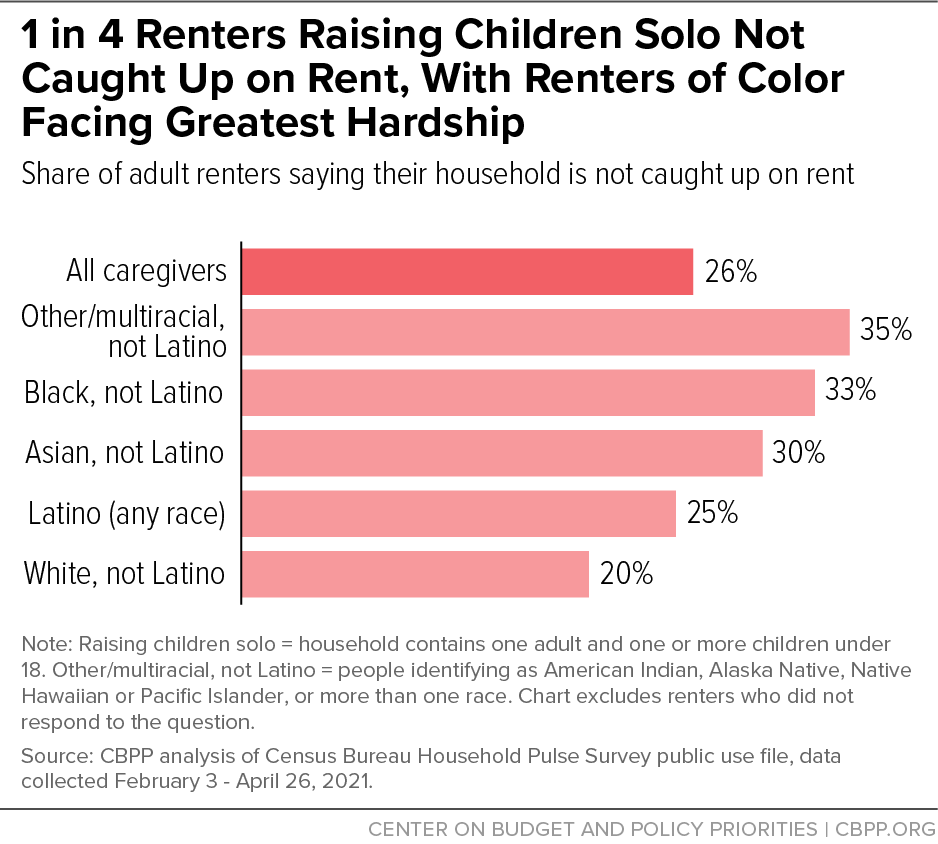BEYOND THE NUMBERS
Hardship Among Solo Caregivers Reveals Need for Rental Assistance, Other Supports
A top priority in recovery legislation should be stronger, more equitable supports for families with children, including a major expansion of rental assistance and in particular Housing Choice Vouchers.
Millions of people were still struggling to make rent and afford food earlier this month, the latest Census Bureau data show. These hardships are especially high for renters raising children alone, particularly women of color, reflecting our nation’s long history of racism, sexism, and discrimination, which has created unequal opportunities in education, employment, and housing for women and people of color.
After some notable improvements in last month’s data, hardship rates held steady. According to the latest data from Census’ Household Pulse Survey, collected April 28 – May 10, 2021:
- 15 percent of renters, nearly 11 million adults, reported that their household was not caught up on rent.
- 9 percent of adults, some 18 million people, reported their household didn’t have enough food in the last seven days.
- 27 percent of adults, some 62 million people, reported difficulty covering usual household expenses — such as food, rent or mortgage, car payments, and medical expenses — in the last seven days.
These national hardship figures mask an uneven economic recovery, particularly for single parents. One in 4 renters who are solo caregivers (defined as an adult renter living with one or more children under 18 and no other adults) reported falling behind on rent between February 3 and April 26. More than 3 in 4 of these solo caregivers are women.
Solo caregivers of color face even higher rates of rent hardship: 33 percent of Black solo caregivers, 30 percent of Asian solo caregivers, and 25 percent of Latino solo caregivers said they were not caught up on rent, compared to 20 percent of white solo caregivers. The rate was 35 percent for American Indian, Alaska Native, Native Hawaiian, Pacific Islander, and multiracial solo caregivers, whom we take as a group due to data limitations. (See chart.)
In addition to struggling to afford rent, renters who are solo caregivers also reported high rates of food insecurity. Nearly 30 percent reported that their household sometimes or often didn’t have enough to eat in the last seven days. And over 40 percent reported either falling behind on rent or not having enough to eat, according to Pulse Survey data.
The COVID-19 crisis has further exposed the inadequacy of the country’s housing assistance programs, particularly for families with children. Even before the pandemic, nearly 8 million children in low-income families faced housing affordability challenges, and more than 1.3 million children experienced homelessness at some point during the 2018-2019 school year. A broad body of research links homelessness, housing instability, overcrowding, and poverty to adverse effects on children’s health, development, and education. This includes cognitive and mental health issues, asthma, and difficulties in school.
To ensure that struggling families can make ends meet, we must invest in policies that support parents and children and address their critical need for affordable housing. The President’s American Jobs Plan calls for major investments in housing construction and rehabilitation, which would support much-needed public housing repairs and affordable housing development, but these would do little to help solo caregivers with incomes at or below the poverty line afford stable housing. In addition, the American Families Plan includes major investments in child care, pre-K education, K-12 teacher preparation, community college, and Pell Grants, but families with unstable or inadequate housing would struggle to fully benefit from the opportunities these investments would create.
As policymakers consider additional recovery legislation, a top priority should be stronger, more equitable supports for families with children. That includes a major expansion of rental assistance — particularly Housing Choice Vouchers — to address housing affordability and promote racial equity. Addressing the housing instability that families with low incomes faced even before the pandemic can create opportunity for all children and build toward a more equitable future.

